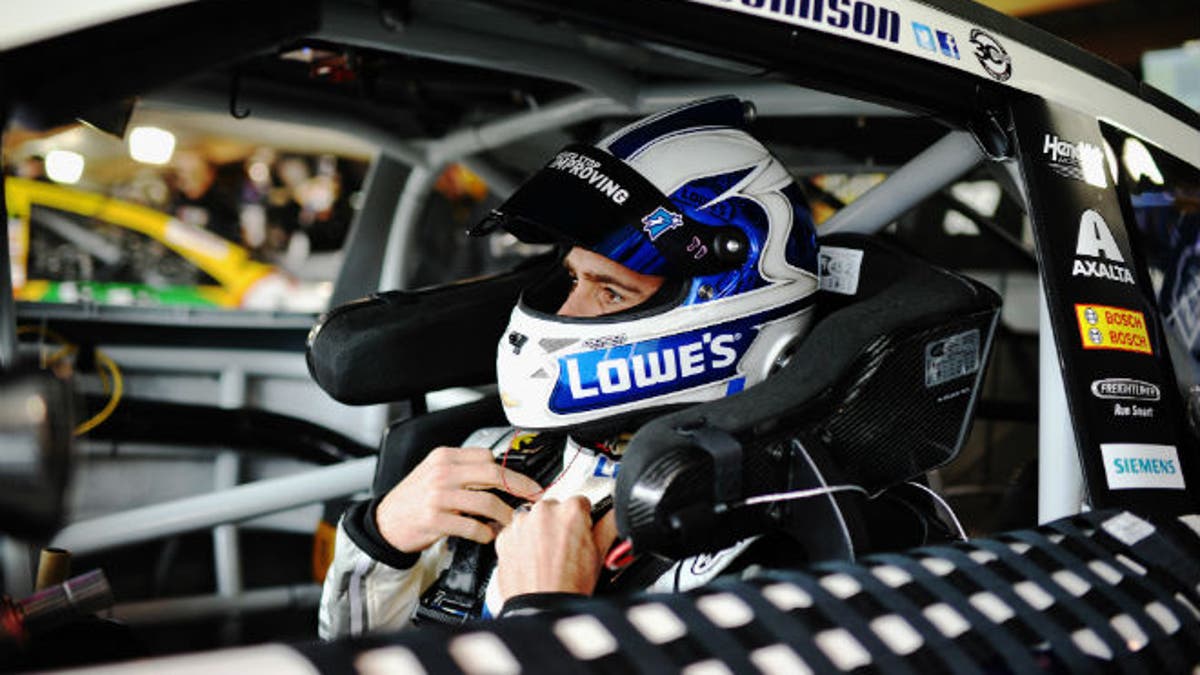
Jimmie Johnson, six-time NASCAR Sprint Cup Series champion and driver of the #48 Lowe's Chevrolet, sits in his car during practice for the NASCAR Sprint Cup Series STP 500 at Martinsville Speedway on March 28, 2014 in Martinsville, Virginia. The HANS device is the collar attached to the helmet via tether; it is also secured to the shoulder harness and seat. (Photo by Rainier Ehrhardt/NASCAR via Getty Images)
While concussions are commonly associated with football and contact sports, race car drivers are at risk, too.
“We’re different than a lot of stick and ball sports because we’re not a contact sport, but we do have accidents and crashes at the race track,” John Bobo, NASCAR’s senior director of racing operations, told FoxNews.com. “We average two or three [concussions] a year.”
Following the 2001 death of Dale Earnhardt from head injuries sustained during a last-lap crash at the Daytona 500, NASCAR has made advances in driver safety, including mandating use of a head and neck support (HANS) device, constructing barrier walls out of crushable material and reinforcing the belt restraints so the driver’s entire body is pinned to the seat.
“The system of tubing restraints in the car that make up the cage around the driver has been markedly strengthened so the driver is sitting in a cocoon, so to speak,” Dr. Robert Cantu, clinical professor of neurosurgery at Boston University School of Medicine and director of sports medicine at Emerson Hospital in Concord, Massachusetts, told FoxNews.com. “That is an incredibly strong structure.”
Almost all head trauma in automobile racing results from collisions, when the head is shaken violently, according to Cantu, who also consults for numerous NFL, NHL and NBA teams. However, accidents aren’t the only cause of concussion.
“The important thing for people to understand is that you don’t have to hit your head to have a concussion and don’t have to have been unconscious to have a concussion,” Dr. Stephen E. Olvey, associate professor of clinical neurology & neurosurgery at University of Miami Health System told FoxNews.com. “If the movement of the head is violent enough and the brain hits the inside of the skull, for example, you can still have significant injury or concussion.
Concussions are caused by rotational acceleration, which occurs when the head is put into motion. If that motion is too violent or extreme, the brain, which is attached to the spinal cord, can rotate or have some shearing injury to the nerve fibers, causing a concussion, Olvey, a founding fellow of the FIA Institute for Motorsports Safety, said.
According to Bobo, NASCAR has almost removed the risk of drivers experiencing rotational force in accidents through implementation of the HANS device and seat restraint safety measures.
Additionally, NASCAR mandated the use of pre-season baseline neurocognitive testing this year, using the ImPACT (Immediate Post-Concussion Assessment and Cognitive Testing) test. In 2002, they introduced a medical liaison department, which keeps records of each driver’s personal medical history and works with every driver’s team, in-field care centers’ board-certified emergency room physicians and outside medical experts, as needed.
“Nothing happens in our drivers’ lives that we haven’t recorded,” Bobo said.
Concussions are recognized by 26 basic symptoms that fall into four different categories— sleep, mood, cognitive and physical, Cantu said. After one to 14 days, roughly 80 percent of victims will no longer have symptoms and will not test for deficits in reaction time, thought processes or other symptoms. For the 20 percent who are still symptomatic after two weeks, it’s possible to have side effects for several years.
While drivers may be hesitant to report injuries, one factor that is uniformly present when a patient is still symptomatic is slow reaction times, both physical and mentally.
“For somebody that’s essentially a fighter pilot on wheels, those reaction times are crucial,” Cantu said. “For an individual to be racing while symptomatic with concussion not only puts themselves at risk but everybody else on the track.”
Notably, Dale Earnhardt, Jr. pulled out of races in 2012 after sustaining two concussions in six weeks, including one he self-diagnosed after a private team test practice.
Education is an important part of keeping drivers safe and NASCAR and their Research & Development Center hold regular driver safety meetings and presentations on health issues, including concussion.
Bobo also noted that NASCAR has revamped their playoff system, the Chase for the Sprint Cup, to an elimination format that allows drivers to take a medical exemption for a race and still make the playoffs.
“I think that change in the rules, it really gives an incentive to report [injuries] if you need to,” he said.
These efforts, many of which were put in place after Earnhardt’s death, are the right way forward, Cantu said.
“NASCAR is to be greatly complimented, I believe, for having spent the many millions of dollars to try to make their sport safer for their drivers,” he said.
